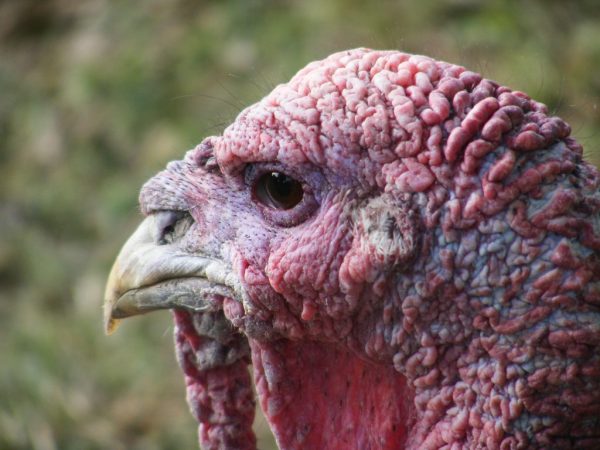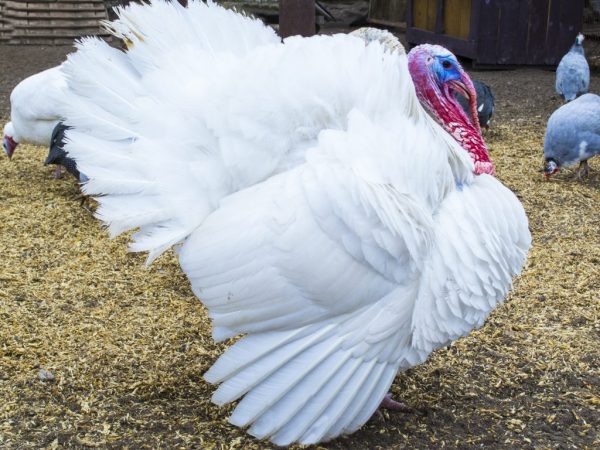How Metronidazole is used for turkey poults
Today, farm poultry in rural areas is far from uncommon, besides the fact that turkey poults are grown for economic purposes, their meat is highly valued not only in the countryside, but also in expensive restaurants in megacities. But only a healthy bird will give a quality product. Therefore, farms, growing birds, should know what metronidazole is for turkey poults, dosage, application and spectrum of action.
- Metronidazole for turkey poults for prevention: instructions
- Instructions for using the drug
- How many days to give birds Metromidazole
- How to give it to the smallest chicks
- Why it is effective to give Metronidazole with liquid
- How to enhance the effect of the drug by external aspects of care
- What will make Metronidazole more effective?

Application of Metronidazole for turkey poults
Metronidazole for turkey poults for prevention: instructions
Poultry meat should be not only tasty, but also necessarily healthy. All pets are sick with one or another ailment. Infections in the body of birds can have a bad effect not only on their growth and development, but also on the human body, which ate their meat.
Bacteria and infections enter the body of the animal through food, feed, water, by infection from other birds.
Parasites can infect the entire body and spread to others, infecting healthy individuals. To minimize such risks, you need to take responsibility to the issue of prevention or treatment using one of the best anti-infectious agents. Most infectious diseases of birds are eliminated with metronidazole.
The instruction says that treatment with metronidazole helps to cope with such diseases as:
- Histomoniasis - weakness, emaciation, weight loss.
- Coccidiosis - defeat by unicellular parasitic viruses.
- Trichomoniasis is an inflammation of the organs of the urinary system.
Signs and symptoms of one of these categories of ailments can include:
- diarrhea;
- green and yellow colors in feathered feces;
- prostration;
- the chick may fall to its feet.
Metronidazole has an antibacterial effect and affects negative cells in the bird's body. It is used not only for treatment, but also for the prevention of the first symptoms of diseases, that is, as a prophylactic agent.
In the composition, together with metronidazole, there is a group of specific components that kill infectious sources of the disease and their carriers. Within the framework of the action of the drug there are many ailments, but, with some types of fungi and spores, he is unable to fight. It is excreted from the body naturally, within 5 hours - 2 days, while it does not have a bad effect on other organs and their vital functions.
Instructions for using the drug

Use the drug according to the instructions
For 100% penetration of the drug into the stomach of the turkey, the best option would be to inject the drug with food. The easiest way is to calculate the dose if you purchased the product in tablets. In appearance, it comes either in the form of the above-mentioned tablets, or in a powder version.It does not have a pungent odor, color and characteristic bitter taste, which will allow the animal to fully swallow the food without noticing it.
How to water turkey poults with metronidazole can be considered with step-by-step instructions. First of all, it is worth remembering about the quality of water at the time of drinking medications. Only boiled, settled liquid is used. the dose is calculated based on the number of birds, as well as on their age and degree of infection.
At normal concentration, about 7 grams of the drug in tablets or powder should be spent per 1 kilogram of feed. If you have a medicine in tablets, before giving it you need to grind it, it is very easy to grind them into powder in advance. The required dose can be thoroughly mixed with a drink or added to young animals ration.
How many days to give birds Metromidazole
The most successful option would be to solder turkey poults with metromidazole for 9 days. After that, to consolidate the course of treatment, dilute at 2.5 g per kilogram of feed or grain.
It should be said that this is a synthetic remedy. the dose and agent for use may depend on the breed and age of the poults, as well as on the concentration and composition of the substance itself.
How to give it to the smallest chicks
the use of the tablet inside is calculated with a slightly different amount:
- 25% tablets, where the active ingredient will be 0.125 g - for 6-6.5 kg of bird weight.
- The same consistency, but half a gram - for a weight of 12.5.
- A 1 gram tablet is designed for 20 kg of animal weight.
- 50% per 0.5 g - the dosage is calculated for a weight of 25 kg.
If the tablets are used with food, it is worth remembering that:
- If the feed is granulated, give 6 g of the preparation per 1 kg of food.
- Accordingly, tablets are 25% nt, where substances of 0.125 g are added in an amount of 24-25 pieces.
- The same consistency, but half a gram - 12 tablets
- The last 2 options are 6 units per 1 gram tablet, and 50 percent in 0.5 g.
- On average, in the form of a 0.1% solution, it is customary to give about 40 mg per 1 kg of bird weight. In this case, the course of treatment should not exceed a maximum of 5 days.
So that the use does not become a whole problem, in the situation with the smallest, use a pipette. Gently opening the baby's beak, put the tip of a pipette into his mouth and drop the required dose of liquid. Continue to do the course of treatment several times a day - 2-3. The drug is also used for the prevention of babies, the methods are the same.

The medicine can be used for prevention.
the drug metronidazole should be given to turkey poults for prophylaxis, according to experts, it will be quite enough once a day in the right amount. Such methods of reinsurance of the health of birds as drinking metronidazole for turkeys will be appropriate in any case.
Why it is effective to give Metronidazole with liquid
the drug metronidazole is given to turkeys in the water much more often than it is added to the feed.
The fact is that in dry food, the drug will sink into the lower layers, due to the buoyancy of the granules. But in water, the drug dissolves just fine, does not create sediment and is absorbed by all animals and livestock at the same time and in the right dosage.
If metronidazole is used for turkeys, its dosage even for the most seasoned birds should be followed strictly according to the instructions. Exceeding or decreasing the dosage can negatively affect the treatment process and the well-being of the birds.
As previously indicated, this drug is often used for the prevention of diseases, which significantly reinsures farmers in the season when all animals begin to get sick and become infected. The product is completely safe, does not cause allergies, side effects, does not settle on the walls and muscles in the form of metals and sediments.
By the way turkey poults are very picky about care, and if you put a young brood in a poorly treated room with inadequate disinfection, they can easily pick up parasites that have remained from the previous generation of owners.And then preventive drinking with the use of metronidazole for turkeys will be a salvation for the young, its insurance.
How to enhance the effect of the drug by external aspects of care
Remember that without proper supervision and conditions of detention, you should not expect any positive effect from the use of metronidazole for turkeys. The younger the pet is, the higher the temperature should be in the room where they stay. The smallest representatives should be warm, the daytime temperature regime is about 26 degrees, at night and in the evening, the regime can be raised by 3-4 degrees. As they grow and develop, the temperature can be significantly lowered by 10 degrees, since the adults are quite hardy and you cannot scare them with the problem of climatic conditions.
What will make Metronidazole more effective?
Through prophylaxis with metronidazole, 100% survival of young animals can be ensured.
Prophylaxis with the use of Metronizadol for other animal species is also of great importance. But, you will not achieve any positive result if you neglect the elementary rules of sanitary standards. Experienced farmers degrease the objects and walls of the room in the old fashioned way, which slightly simplifies the processing and cleaning of the placenta. At the same time, it is worth remembering that different species and breeds of domestic farm animals have their own characteristics in the content and specific diseases that only chickens, geese or turkeys suffer from.
Keeping them in different chicken coops or barns is not essential, but at the same time it is worth thinking about safety, separating the feeders and even if possible, finding an alternative universal feed, because with a large number of farms, it is impossible to control who eats from whose feeder.
To prevent other microbes from entering the body of the chick and livestock along with medicines, think about supplying containers a little higher than the floor level. The litter should always be clean and fresh, and the water is at a temperature that the animal can safely drink. From time to time, you need to poison rodents - carriers of diseases and, of course, insect parasites that like to settle in feathers and hair. Then babies and adult turkeys will be completely safe.


